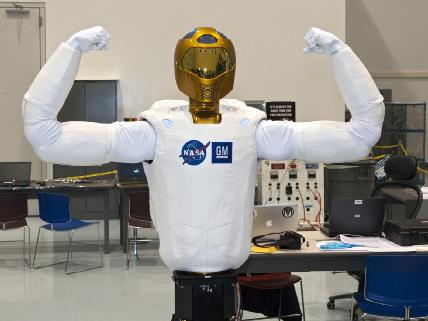Develop an algorithm for an astronaut robot and win 10 thousand dollars

[From the translator: Perhaps you remember that a few months ago, NASA, together with TopCoder, held a competition to develop an algorithm for the movement of solar panels on the ISS, which was also mentioned on Habré. Now the agency is launching a new project - this time with the goal of developing software for an astronaut robot. The prize fund of each of the stages of the competition will be $ 10,000, but the opportunity to develop software that will work in space is worth any money, isn't it?
NASA is asking Earth programmers to teach an astronaut robot to see.
')
Robonaut 2 - a humanoid robot being tested on the ISS - designed to do both daily and more complex work and help make life easier for the station’s crew. Until now, the robot (which NASA shortly called R2) did only trivial, everyday tasks, communicated using sign language, well, and learned to shake hands with the crew.
However, the agency believes that the robot is capable of more, so, together with TopCoder, it launched a series of competitions that will give 470 thousand developers a chance to help the robot “see” and better interact with the station equipment.
 Each of the contests will last three weeks, and will have a prize fund of $ 10,000. By the time of publication of this article [Available in original publication form - April 2, 2013, - comment.] , 533 people have already registered to participate in the first stage, and 10 of them have already submitted their algorithms.
Each of the contests will last three weeks, and will have a prize fund of $ 10,000. By the time of publication of this article [Available in original publication form - April 2, 2013, - comment.] , 533 people have already registered to participate in the first stage, and 10 of them have already submitted their algorithms.In the end, the competition will help the robot successfully perform repetitive, daily, monotonous work, and thus relieve astronauts.
The first stage is a competition for the development of an algorithm that will help the robot determine whether the switches and buttons on the dashboard are turned on or off. Of course, NASA provided photos of the station’s panels. It is worth considering that these panels have different configurations.
“A successful algorithm should be able to work with each of several camera systems [the robot has 4 conventional and one infrared camera, and it’s recommended) , and overlay the coordinate grid for each of the panels,” says a TopCoder representative.
The second stage will be a continuation of the first - using the created algorithm, developers will have to write code that will already directly control the hands of the robot.
“The software will have to“ see ”the object, recognize it, and properly interact with it in the most efficient and safe way,” said TopCoder representatives.
The robot, worth about 2.5 million dollars, weighs 149 kilograms, and consists of a torso, arms and head, and its height is about one meter. NASA delivered it to the ISS in 2011 during the last flight of the shuttle Discovery.

Recall that earlier NASA and TopCoder had already organized a number of contests: a contest with a $ 30,000 prize for developing an algorithm for moving the ISS solar panels, a contest for a medical monitoring algorithm with a prize of $ 24,000, and a contest for developing search algorithms in a 100 terabyte NASA database accumulated over 30 years of space research, with a prize of $ 13,000.
TopCoder also held a competition to develop an application for the iPad Space Station Food Intake Tracker, which allows you to follow the diet that astronauts adhere to, and organized the Voice Command Idea Generation project.
"It seems to us that our [with NASA] joint efforts aimed at improving Robonaut 2, as well as our PDS and FIT projects, successfully show that such complex and important software solutions can be developed by a new generation of engineers and programmers for very reasonable amounts . We believe that this is very important for promoting innovation to the masses, ”said the president of TopCoder, Rob Hughes.
If you are interested in this project, visit its page on TopCoder , citizens of any country can take part.
Thank you Zelenyikot for the tip on the material.
Please report errors and typos in PM.
Source: https://habr.com/ru/post/175293/
All Articles